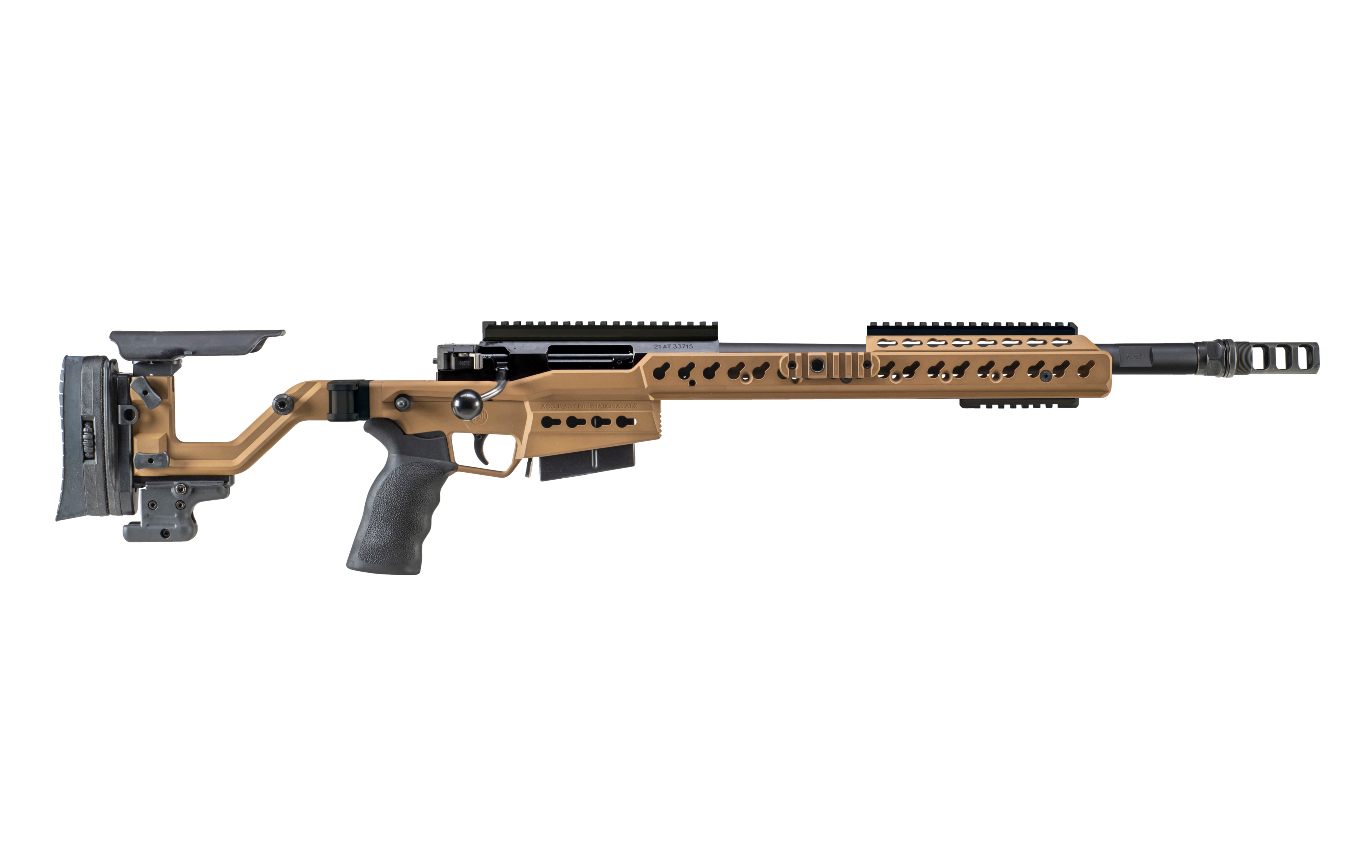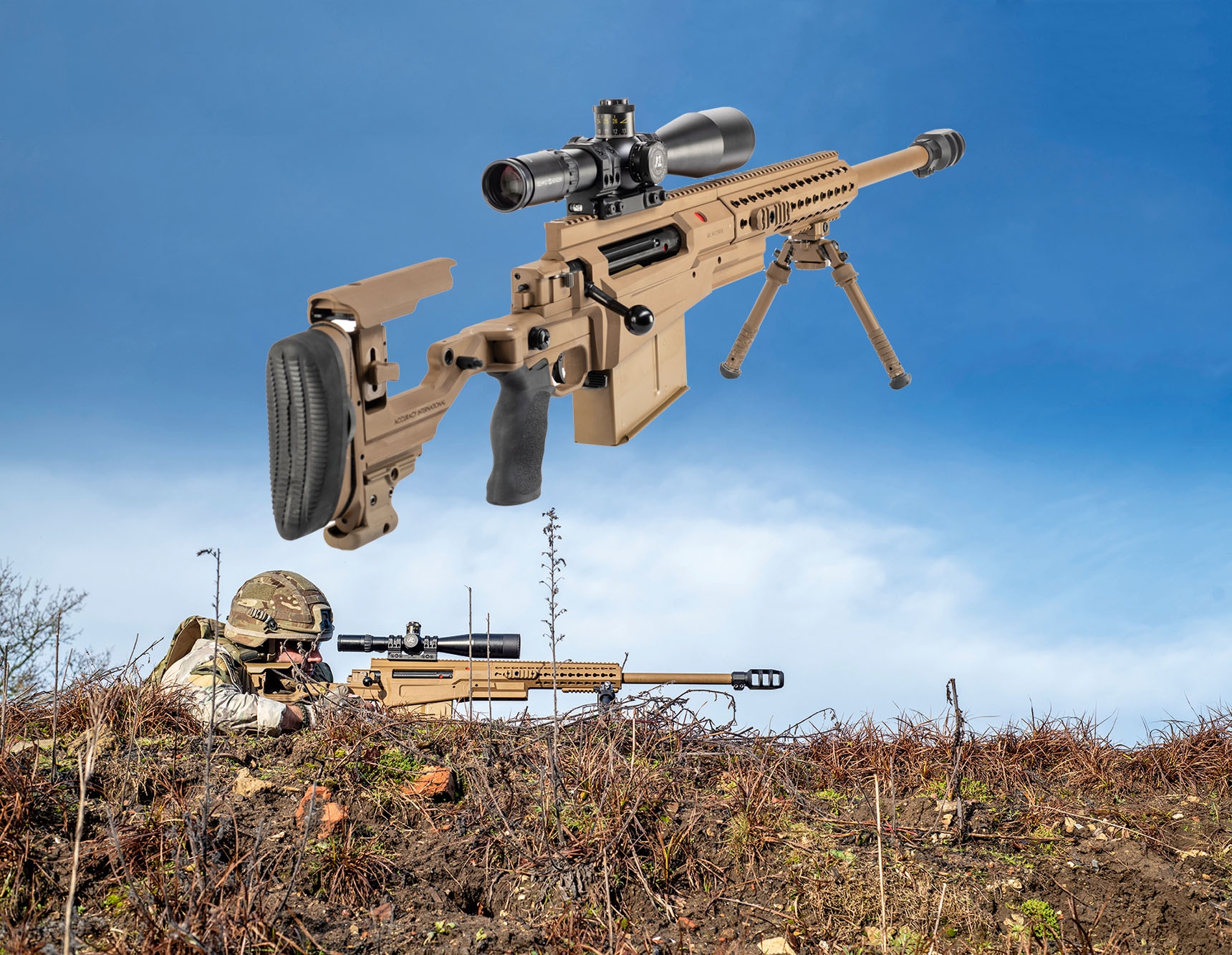The first model series to be produced on a larger scale by the British manufacturer Accuracy International from Portsmouth for the snipers of various armed forces was the Accuracy AW (Artic Warfare). The AW series, which was marketed from 1988, was available in different versions over the course of time. For example, the AWF (Artic Warfare Folding) with folding stock, the integrally suppressed AWS (Artic Warfare Suppressed), the AW50 in .50 BMG (here is the test report from all4shooters.com) or the AWM (Artic Warfare Magnum) and others. The latter was put into service by the Bundeswehr in 1997 as the G22 in .300 Winchester Magnum (7.62x67mm). In 2019, the G22 was modernised for the last time for German snipers under the designation G22A2. The weapon is still in service with the troops. In addition to the AW model series, there were other model series such as AE (Accuracy Enforcement) and AT (Accuracy Tactical). The AX model series, from which the test rifle also originates, was introduced in 2010.
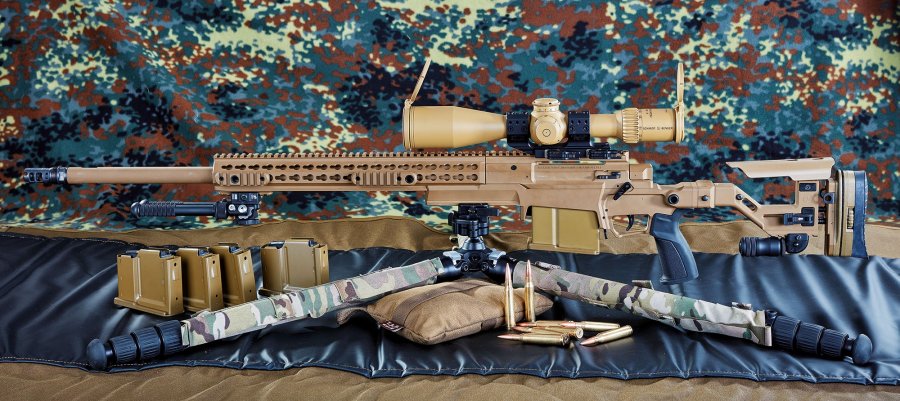
The stock of the Accuracy International AXSR rifle
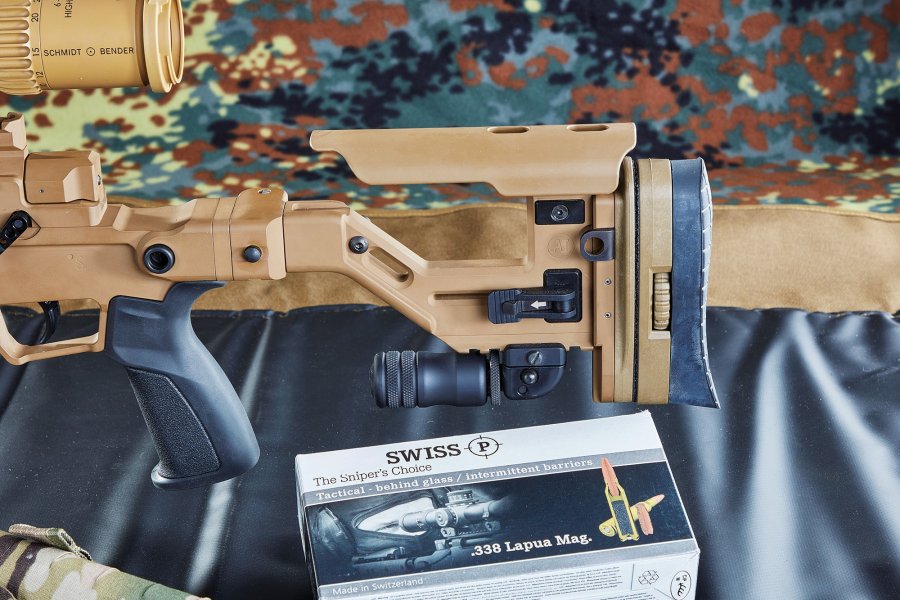
The stock of the AXSR leaves nothing to be desired when it comes to individual adjustments to suit the shooter's needs. The body is made of an aluminum alloy and has a very solid design. After loosening a knurled thumbwheel behind the butt pad, the pad can be rotated 360 degrees in any position and fixed again. Using this thumbwheel, the butt pad can also be infinitely adjusted upwards by 13 mm and downwards by 27 mm from the zero position. Once the wheel has been tightened, there is absolutely no play in the height and set position. A throw lever is located in the axial extension of the wheel. This is secured against unintentional opening. After pressing the safety lock and opening the lever, it must be pressed slightly inward to slide it out. Length of pull can then be adjusted. In order to set the appropriate length of pull for the shooter, the stock is designed to be fully extended, the shooter moves to the aiming position and reduces the stock length pressing with the shoulder until the correct eye relief to the eyepiece is set. Two parallel guide rods connect the butt pad and body and also serve as an anti-rotation device. The maximum adjustment range is 55 millimeters in steps of 1.5 millimeters.
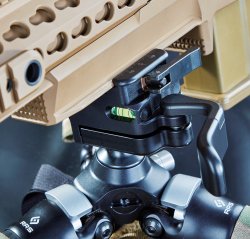
A second throw lever with safety lock is responsible for adjusting the cheek piece height. When this is opened, the cheek piece automatically moves to the top position with spring assistance. Here too, the shooter moves back to the aiming position and presses his/her cheek piece downwards until the eye and the riflescope's longitudinal axis are levelled. The height adjustment range is 24 mm, again in steps of 1.5 mm. In addition, the cheek piece can also be offset by 15 degrees to the right or left. As a further adjustment option, the cheek piece can be moved axially by around 5 mm. A 70-mm long Picatinny rail is machined out of the body on the underside of the stock. It is designed to accommodate a rear grip or a butt spike. A monopod from Accu Shot was fitted to the test gun. This offers a height adjustment range of 30 mm at the touch of a button. The base of the monopod can be infinitely finely adjusted using a threaded stud. To increase stability, the foot can be clamped with a knurled nut on the threaded stud. The folding stock joint is extremely solidly dimensioned. Thanks to the locking mechanism and built-in Teflon bushings, the buttstock can be moved with even resistance.
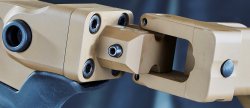
The joint is absolutely free of axial and radial play. Folding the stock on the right side of the rifle shortens the length by 208 millimetres. To unlock, simply pull the stock with a little force.
The chassis accommodates the hand guard at the front, the barreled action in the centre and the folding stock joint at the rear. An Arca trapezoidal rail is located in front of the magazine well as an interface for tripods. A barrier stop is located in front of and behind the rail. This allows the rifle to be tilted and rested on an obstacle. The steel action is connected to the aluminum chassis via five screws.
Technical details of the action, bolt and trigger of the AI AXSR
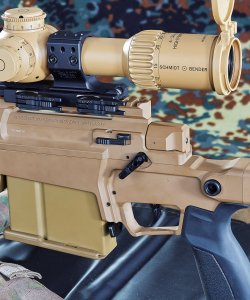
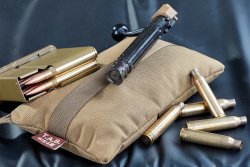
The bolt head has a total of six lugs on two levels. This results in a classic throw angle of 60 degrees. The corresponding locking recesses are machined out of the action. A case extractor and an ejector are responsible for ejecting the case. The magazine well is generously cut on the left side of the gun. This is intended to allow the magazine to be inserted from the side into the magazine well, which is particularly helpful when shooting prone, as the rifle does not have to be raised. The sheet steel magazine holds ten cartridges in two columns. The two-position safety is located below the bolt handle and is ambidextrous. The safety acts on the firing pin and blocks it. In the "safe" position, the bolt can be opened and also removed.
The trigger is a two-stage type. Its pull weight was set to 12.2 N or 1,250 g on the test gun. According to the manufacturer, a pull weight of between 1,500 and 2,000 grams can be set. Another adjustment option offered by the trigger is the trigger blade. This can be moved axially by a total of around 10.5 mm after loosening a screw on the trigger blade guide. This allows the trigger to be adjusted for fingers of different lengths. The characteristics of the trigger are excellent: pre-travel and take-up without creep or overtravel and the trigger releases with absolute definition.
Accuracy International AXSR, a multi-caliber system
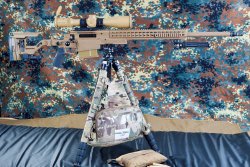
The AXSR is available as standard in the following chamberings: 6.5 Creedmoor with 24- or 26-inch barrel length and 1:8 twist rate; in .308 Winchester and .300 Winchester Magnum the barrel length is 26 inches, the twist rate is 1:10" or 1:11" for the .300 Win.Mag. 27-inch long barrels with a 1:9.35" twist rate are used in the .338 LM. In the USA, interchangeable systems are also available in .300 Norma Magnum and .338 Norma Magnum. To remove the barrel, the barrel clamp screw on the action must first be loosened using an Allen key. The barrel can then be unscrewed from the action by hand. If the manual force is not enough for the release torque, there are two so-called barrel flats with a spanner width of 22 mm or 7/8 inch on the barrel near the muzzle. The barrel can now be removed and replaced with an interchangeable barrel. This is screwed into the action by hand. Ensure that the barrel flange is flush with the action. To check this, there is an inspection slot on the side of the action. The barrel clamp is then tightened with the Allen key and a torque of 5.5 Nm. To prevent damage to the barrel and action thread, it is best to install and remove the barrel clamp with the rifle standing vertically on the butt pad. Finally, the appropriate bolt and magazine are inserted. To identify the correct bolt, barrel and magazine, these have corresponding markings depending on the caliber. "One dot" stands for the .308 Winchester, "two dots" for the .300 Winchester Magnum and "three dots" for the .300 Norma Magnum, .338 Norma Magnum and .338 Lapua Magnum.
On the shooting range with the Accuracy International AXSR
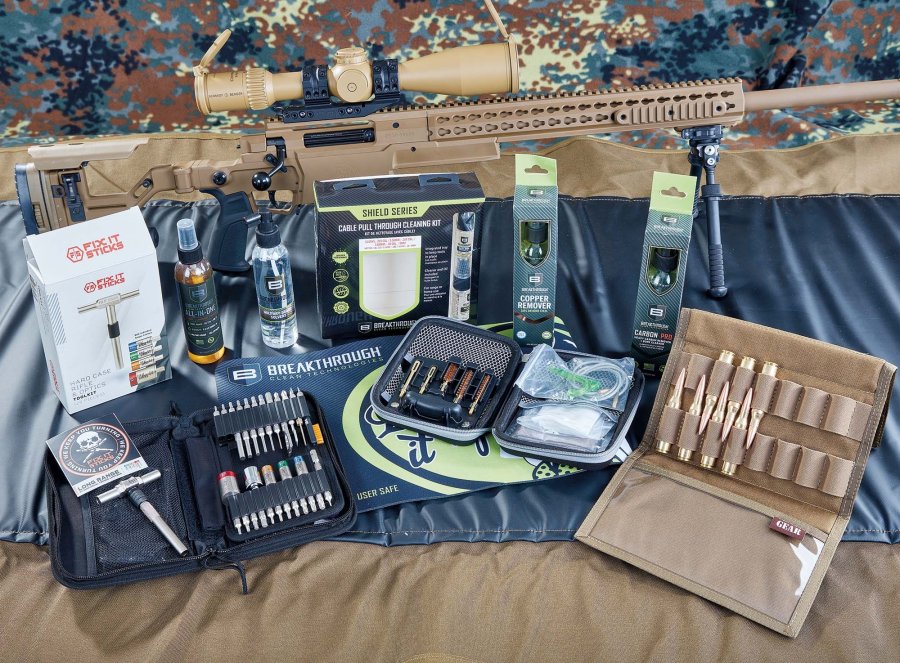
Surprise during the test planning: Lapua no longer offers any ammunition for the civilian market in .338 LM, with the exception of the hunting Naturalis load, no cases and no bullets such as Scenar or Lock Base. For this reason, the testers decided to also include some official loads from MEN Defencetec and Swiss P Defence AG (formerly RUAG Ammotec AG) in the test, mainly because there are hardly any differences between the AXSR MIL and the AXSR C.
The test rifle was fitted with a Schmidt & Bender 6-36x56 PM II High Performance scope with LPI GR²ID reticle on a Spuhr QDP-4016 block mount.
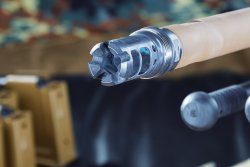
A B&T PRS Atlas Bipod with ADM-170-S lever was mounted on the lower Picatinny rail of the handguard and a B&T BT13-QK Accu Shot Monopod on the underside of the buttstock. This equipment was also used to shoot the groupings at 100 and 300 metres. In addition to the sheer number of individual adjustment options on the stock, the very pleasant recoil impulse of the test rifle was particularly noticeable. However, the gun also weighed just under nine kilos ready to fire. The design of the gun is such that the feed lug on the bolt head is blocked in the open position by the magazine follower as soon as there are no more cartridges in the magazine. To close the bolt, either the feed ring must be pressed down or the magazine must be removed.
To determine accuracy, the Accuracy International AXSR was therefore shot without a magazine and, as usual, each cartridge was loaded individually directly into the chamber. As is to be expected for a gun in this price range, the British rifle had no technical weaknesses whatsoever. The cases were extracted and ejected cleanly, and all adjustments made to the stock remained in position and were firm. The AI AXSR also has nothing to hide when it comes to accuracy. Seven of the eleven loads delivered sub-MOA accuracy at 300 meters at the first attempt (grouping smaller than 87 mm). With 14 mm or 0.48 MOA, the official Swiss P Ball load at 100 meters and the MEN Sniper Line Match with an outstanding 36 mm or 0.41 MOA at 300 meters delivered the best results.
Accuracy International AXSR technical specifications and price
Model: | Accuracy International AXSR |
Caliber: | .338 Lapua Magnum |
Capacity: | 10 + 1 cartridges |
Length: | 1,229 mm / 1,021 mm Folding stock laid out |
Running length: | 689 mm butt end to mouth |
Twist length: | 1:9.35" (1:237 mm), 6 slides, right-hand twist |
Trigger weight: | 1,248 g / 12.2 N Pressure point trigger |
Weight: | 7.390 g |
| Price (MSRP in the US): | $9,895 |
Features: multi-caliber bolt-action rifle, height-adjustable and cheek piece and adjustable butt pad, length-adjustable folding stock, mounting rail with 20 MOA forward tilt, adjustable two-stage trigger, hand guard with Picatinny rails and KeyMod slots, 10-round double-stack sheet steel magazine, dual-chamber muzzle brake with threaded silencer mount. | |
Conclusion on the Accuracy International AXSR bolt-action rifle
The Accuracy International AXSR offers many adjustment and mounting options on the chassis side. The workmanship is outstanding and the adjustable trigger works excellently. In addition, the gun offers several caliber change options by replacing the barrel, bolt and magazine. It would actually be a clear recommendation to buy, were it not for the very high purchase price –$9,895 in the US. This puts the AXSR at the same price level as a Sako M10 or Steyr SSG M1, but also several thousand euros above a Voere X3, Unique Alpine TPG 3 A4 or the Haenel RS 9/HLR 338 Pro.
| What we liked: |
What we didn't liked |
- Very well made | - Very high purchase price |
| - Many adjustment options | |
| - Very good trigger | |
| - Pleasant shooting behaviour |



